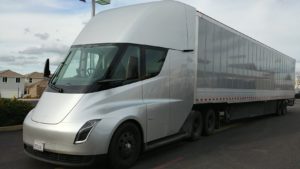Why Trucking Is a Bellwether of the Future of Sustainability

We stand at an important threshold for businesses wanting to change the world. For the very first time, the economic and environmental benefits of green energy are aligned.
As the cost of renewable energy continues to plunge, it has drawn ever closer to the lower costs of coal- and gas-fueled electricity. This year, European carbon cost rose over roughly $23 per ton for the first time since 2008. And according to financial advisory firm Lazard, the cost of building and maintaining renewable energy projects can be lower than the operating price of conventional power-generation methods.
The message is clear: We’ve reached a break-even point where the benefits of sustainable business practices outweigh the costs. We can and should start making changes to our businesses right away.

Even the most unlikely figures are making the shift. Texas, the oil and gas capital of the Western world, is a huge adopter of alternative energy. The state has nearly 22,600 megawatts of wind power, and it added 2,300 just last year. If Texas can seize the opportunity of alternative energy, we all can.
More impressive, this commitment is not at the sacrifice of grid costs. Electricity prices for Texas residents have actually decreased and are now far below the U.S. average.
We know that fossil fuels are inefficient and that the viability of alternative energies can’t be ignored. Because of this, we’re sure to see many more exciting innovations that transform the way we live, travel, and work. A perfect example? The good old American truck.
When Electric Beats Diesel

Trucks have long been vital to the U.S. economy. As symbols of the vastness of our landscape and bastions of oil and gas, they are the most heavily used mode of transport for domestic trade, according to the American Trucking Associations. In fact, trucks carry a staggering 71 percent of U.S. freight by weight.
Diesel has traditionally been the driver of this industry. But it’s a famously inefficient form of energy, so the alternatives — electric vehicles — are pushing ahead.
Tesla is one of the first companies taking advantage of the new economies of scale gracing renewable energy. The company’s new truck, the Semi, represents the next generation of electric vehicles. The Semi has a range of 500 miles, putting it into long-haul territory, and it promises to save 20 percent on diesel’s operating costs. To complement the adoption of these trucks, shiny new “megachargers” are being developed to lower adoption barriers. Corporate giants such as PepsiCo Inc. and FedEx have already ordered their fleets from Tesla.
Different automotive brands are following Tesla’s lead. Rival company Daimler AG announced its E-Fuso Vision One late last year, which offers truckers a heavier-duty transportation option, albeit one with a shorter range. UPS Inc. also announced a partnership with Thor Trucks in an aim to develop the “fleet of the future.”
It’s clear that much of the corporate world is rallying behind the shift to electric, but diesel isn’t going down without a fight. Proponents of the fuel predict that diesel’s potential efficiency can rival electric’s.
Right now, though, the cost of operating Tesla’s electric truck is reportedly $1.26 per mile instead of diesel’s $1.51. Applied to long-distance hauls, the savings become sizable. But with regulations and shifting demand dogging diesel companies, this old U.S. standby might just gear up for a new era of domination.
What does this all mean? In short, we’re hurtling toward a new age of sustainable travel. When upfront investment costs merge, operating costs tip the scale in favor of new technology. And with the support of regulations and infrastructure, change is inevitable. A Muskian vision of the world — electric trucks soaring past solar-powered buildings on permeable grid paving — could soon be the norm.
To learn about how to build and develop sustainably, follow along on TRUEGRID’s blog.

